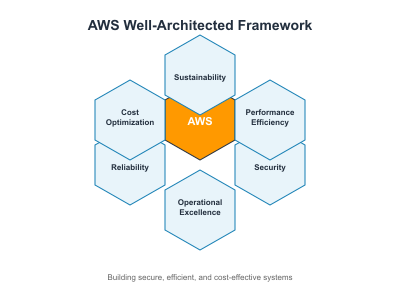AWS Well-Architected Framework: Building Resilient, Secure, and Efficient Cloud Architectures
 Gedion Daniel
Gedion Daniel
The AWS Well-Architected Framework provides a systematic approach to evaluating and building cloud architectures. It represents Amazon Web Services' accumulated experience and best practices in cloud architecture, offering guidance across six fundamental pillars of excellence.
Understanding the Six Pillars
Operational Excellence
Operational excellence focuses on running and monitoring systems effectively while continuously improving processes and procedures. Key aspects include:
The ability to run workloads consistently and predictably is paramount. Organizations achieve this through automation, responding to events, and defining standards for daily operations. Infrastructure as code, comprehensive documentation, and regular refinement of operational procedures form the foundation of this pillar.
Security
Security represents the capability to protect information, systems, and assets. AWS emphasizes comprehensive security measures at every layer of the architecture. This includes protecting data confidentiality and integrity, managing user permissions through identity and access management, and maintaining security at scale through automation.
Reliability
Reliability encompasses a system's ability to recover from disruptions, dynamically acquire computing resources, and mitigate disruptions. This pillar focuses on ensuring systems perform their intended functions consistently and correctly.
AWS recommends implementing automatic recovery procedures, horizontal scaling to increase aggregate system availability, and testing recovery procedures regularly. The goal is to recover quickly from infrastructure or service disruptions.
Performance Efficiency
Performance efficiency examines the ability to use computing resources efficiently and maintain that efficiency as demand changes and technologies evolve. This includes selecting the right resource types and sizes based on workload requirements, monitoring performance, and making informed decisions to maintain efficiency.
Organizations should leverage serverless architectures where possible, experiment frequently with new services, and consider mechanical sympathy in their architectural decisions.
Cost Optimization
Cost optimization ensures systems deliver business value at the lowest price point. This involves understanding and controlling where money is being spent, selecting appropriate resource types and quantities, and scaling to meet business needs without overspending.
Key practices include implementing cloud financial management, adopting a consumption model, measuring overall efficiency, and stopping to spend money on undifferentiated heavy lifting.
Sustainability
The sustainability pillar focuses on minimizing the environmental impacts of running cloud workloads. This involves:
Understanding the environmental impact of cloud services, establishing sustainability goals, maximizing utilization to minimize required resources, and adopting new, more efficient hardware and software offerings.
Implementation Strategy
Design Principles
The framework emphasizes several overarching design principles:
Stop guessing capacity needs through scalable solutions. Test systems at production scale to validate architecture. Automate architectural experimentation to reduce the cost of innovation. Consider evolutionary architectures that can adapt to changes. Drive architectures using data-based decisions. Improve through regular game days and failure testing.
Best Practices Application
Organizations should approach the Well-Architected Framework through:
Regular Assessments
Conduct periodic reviews of architectures against the six pillars. Document findings and create actionable improvement plans. Prioritize improvements based on business impact.
Documentation
Maintain comprehensive architecture documentation. Record design decisions and their rationale. Keep documentation updated as architecture evolves.
Continuous Improvement
Regularly review and update architectural decisions. Implement feedback loops for continuous refinement. Stay current with new AWS services and features.
Tools and Resources
AWS Well-Architected Tool
AWS provides a free tool to review architectures against the framework's best practices. This self-service tool offers:
Consistent process for architecture reviews Measurements against best practices Guidance for improvements Historical tracking of improvements
Support Options
AWS offers various support mechanisms:
Well-Architected Framework whitepapers AWS Solutions Architects consultation Partner network expertise Online training and certification
Business Benefits
Implementing the Well-Architected Framework provides several key benefits:
Risk Reduction
Comprehensive security controls Reliable system operations Reduced probability of business-impacting events
Efficiency Gains
Optimized resource utilization Reduced operational overhead Improved cost management
Innovation Enablement
Faster experimentation capability Reduced cost of failure Improved ability to adopt new technologies
Conclusion
The AWS Well-Architected Framework serves as a comprehensive guide for building and maintaining efficient, secure, and reliable cloud architectures. By following its principles and regularly assessing architectures against its pillars, organizations can create sustainable, high-performing cloud environments that deliver business value while managing costs effectively.
Regular review and application of the framework's principles help ensure cloud architectures remain aligned with best practices and business objectives while adapting to changing requirements and emerging technologies.
For detailed information and implementation guidance, organizations should consult the AWS Well-Architected Framework documentation and engage with AWS architecture specialists as needed.
Subscribe to my newsletter
Read articles from Gedion Daniel directly inside your inbox. Subscribe to the newsletter, and don't miss out.
Written by

Gedion Daniel
Gedion Daniel
I am a Software Developer from Italy.